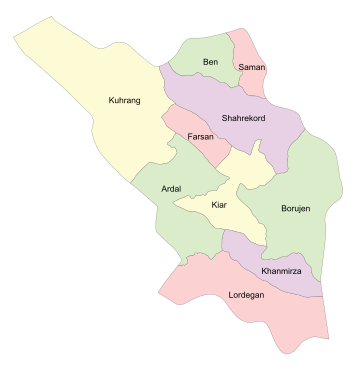Chaharmahal and Bakhtiari province facts for kids
Quick facts for kids
Chaharmahal and Bakhtiari province
استان چهارمحال و بختیاری
|
|
|---|---|

Location of Chaharmahal and Bakhtiari province in Iran
|
|
| Country | Iran |
| Region | Region 2 |
| Capital | Shahr-e Kord |
| Counties | 11 |
| Area | |
| • Total | 16,332 km2 (6,306 sq mi) |
| Population
(2016)
|
|
| • Total | 947,763 |
| • Density | 58.0310/km2 (150.300/sq mi) |
| Time zone | UTC+03:30 (IRST) |
| Main language(s) | Luri language Persian Qashqai Turkish |
| HDI (2017) | 0.798 high · 13th |
Chaharmahal and Bakhtiari province (Persian: استان چهارمحال و بختیاری, Ostân-e Čahâr-Mahâl-o Baxtiyârî) is one of the 31 provinces of Iran. It lies in the southwestern part of the country, with an area of 16,332 square kilometers. Its capital is Shahr-e Kord. At the 2006 census, the province's population was 843,784 in 194,171 households. The following census in 2011 counted 895,263 people in 234,416 households. At the 2016 census, the province's population was 947,763 in 270,434 households.
The province was classified as part of Region 2 upon the division of the provinces into 5 regions solely for coordination and development purposes on June 22, 2014.
Contents
Administrative divisions
| Administrative Divisions | 2006 | 2011 | 2016 |
|---|---|---|---|
| Ardal County | 68,740 | 53,514 | 48,880 |
| Ben County1 | — | — | 28,326 |
| Borujen County | 113,795 | 118,681 | 122,483 |
| Falard County2 | — | — | — |
| Farsan County | 90,111 | 93,941 | 95,286 |
| Khanmirza County2 | — | — | — |
| Kiar County3 | — | 58,047 | 50,976 |
| Kuhrang County | 33,468 | 35,915 | 41,535 |
| Lordegan County | 175,289 | 194,783 | 209,681 |
| Saman County1 | — | — | 34,616 |
| Shahrekord County | 362,381 | 340,382 | 315,980 |
| Total | 843,784 | 895,263 | 947,763 |
| 1Separated from Shahrekord County 2Separated from Lordegan County 3Separated from Ardal County and Shahrekord County |
|||
Cities
According to the 2016 census, 607,444 people (over 64% of the population of Chaharmahal and Bakhtiari province) live in the following cities: Aluni 5,248, Ardal 10,113, Babaheydar 11,202, Bazoft 1,519, Ben 12,971, Boldaji 11,980, Borujen 57,071, Chelgerd 2,989, Cholicheh 4,945, Dashtak 4,016, Dastana 5,143, Faradonbeh 13,317, Farrokh Shahr 31,739, Farsan 30,504, Gahru 6,263, Gandoman 6,291, Gujan 6,179, Hafshejan 21,352, Haruni 3,601, Junqan 14,433, Kaj 4,227, Kian 12,948, Lordegan 40,528, Mal-e Khalifeh 4,024, Manj 1,492, Nafech 4,059, Naghan 6,125, Naqneh 9,923, Pardanjan 8,699, Saman 14,192, Samsami 1,203, Sar Khun 2,131, Sardasht 5,691, Sefiddasht 5,471, Shahr-e Kord 190,441, Shalamzar 6,899, Sudjan 5,581, Sureshjan 12,308, Taqanak 6,170, and Vardanjan 4,456.
Languages
Bakhtiāri, which belongs to the Luri language of the Iranian language family, is the province's main language. Bakhtiāri is primarily spoken in the valleys of the higher areas in the western half of the province. It is also spoken in the lower areas around Lordegān in the south, and by speakers who have moved into the cities in the north-east.
In the north-east quarter of the province, people in most cities and villages speak either Chārmahāli (also in the Southwestern branch of Iranian) or Chaharmahali Turkic. Chārmahāli is transitional between Bakhtiari and Persian varieties of Isfahan province, but more similar to the latter. Chārmahāli varieties spoken in cities include Dehkordi (in Shahr-e Kord), Ghafarrokhi (in Farrokh Shahr), Heysheguni (in Hafshejān), and Borujeni (in Borujen). There are also many other varieties of Chārmahāli spoken in rural areas. Most types of Turkic spoken in this province are similar to Qashqa’i of Fars province, but they are transitional to the Āzarbāyjāni (Azerbaijani) language of north-west Iran. The Chārmahāli and Turkic language areas overlap with one another, and in the foothills of the Zagros and in the larger cities, they intermingle with Bakhtiāri as well.
Tehrani-type Persian is now being taught by parents to children as a first language in some parts of the province, with the highest concentrations in the cities.
| Chaharmahal and Bakhtiari Linguistic Composition | ||||
|---|---|---|---|---|
| language | percent | |||
| Luri | 61.88% | |||
| Persian | 20.3% | |||
| Turkic | 17.80% | |||
| Other, mixed | 0.02% | |||
The Atlas of the Languages of Iran (ALI) published a series of language maps for Chahar Mahal and Bakhtiari province, including a point-based and polygon (area-based) language distribution maps, and several linguistic data maps.
Written descriptions of some of the Bakhtiāri varieties in the province. and a lexicon of the Bakhtiāri language have also been published.
Economy
The province is mainly active in the agriculture sector. Most of the industrial sector is clustered around the center of the province.
The province has the potential to become a vibrant tourist attraction because of its natural resources.
Natural attractions
Chaharmahal and Bakhtiari province is the source and birthplace of many springs, rivers and waterfalls that supply the water of the two great and vital rivers of Zayanderud and Karoon and cause the development of many cities in the country. Natural attractions include Zayanderud river, Zamankhan bridge, Kouhrang 1 Dam, Dime spring, Sheik Ali Khan waterfall, Chama Ice cave, Darkesh varkesh canyon, Rostam Abad Sardab spring, Do Polan, Karoon-4 dam, Darreh Esgh (love valley), Atashgah waterfall, Choghakhor Wetland, Pire Ghar cave, Siasard spring, Helen protected area, Barm spring, Sendegan spring, Tang Sayyad national Park, Parvaz national park, Sarab cave, Gandoman wetland, Zard lime waterfall, Kordikon waterfall.
Colleges and universities
- Islamic Azad University of Borujen
- Islamic Azad University, Shahrekord Branch
- Shahrekord University
- Shahrekord University of Medical Sciences
See also
 In Spanish: Provincia de Chahar Mahal y Bajtiarí para niños
In Spanish: Provincia de Chahar Mahal y Bajtiarí para niños



